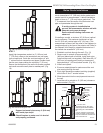
6
RFSDV24/34 Freestanding Direct Vent Gas Fireplace
10003550
12” (305 mm)
A
12”
(305 mm)
B
E
C
D
FP1620
locate freestanding
Top of Unit to Ceiling ............................... 36” (914 mm)
Appliance
Back ........................................................
0” (0 mm)
Side ...................................................
12” (305 mm)
Floor ........................................................
0” (0 mm)
Corner .............................
0” (0 mm) to Back Edges
Vent Pipe ...............................................
1” (25 mm)
Clearance to Combustibles
High Elevations
Input ratings are shown in BTU per hour and are
certified without deration for elevations up to
4,500 feet (1,370 m) above sea level.
For elevations above 4,500 feet (1,370 m) in USA,
installations must be in accordance with the cur-
rent ANSI Z223.1/NFPA 54 and/or local codes hav-
ing jurisdiction.
In Canada, please consult provincial and/or local
authorities having jurisdiction for installations at
elevations above 4,500 feet (1,370 m).
Natural LP (Propane)
Inlet Minimum 5.5” w.c. 11.0” w.c.
Inlet Maximum 14.0” w.c. 14.0” w.c.
Manifold Pressure 3.5” w.c. 10.0” w.c.
Gas Inlet and Manifold Pressures
Preparation
The use of wallpaper adjacent to this fireplace is not
recommended, as the high heat given off by this fire-
place may adversely affect the binders in the adhesive
used to apply the wallpaper.
Before beginning, remove the window frame assembly
from the fireplace. Also check to make sure there is not
hidden damage to the fireplace. Take a minute and plan
out the gas, vent and electrical supply. Refer to Window
Frame Assembly Removal Section.
A) Flat on wall* B) Room Divider* C) Island
D) Cross Corner E) Flat on wall corner
Note (Fig. 2): *(A) and (B) must maintain a 12” (305 mm)
clearance between the wall and side glass of fireplace.
Locating Your Fireplace
Fig. 2 Locate gas fireplace.
FP1620
There is a minimum vertical rise required
for the venting, which varies depending on
the application. The maximum horizontal
run also has restrictions. Before starting
the installation, become familiar with vent-
ing instructions starting on Page 9.
Gas Specifications
Max. Min.
Input Input
Model Fuel Gas Control BTU/h BTU/h
RFSDV24RN Nat Millivolt Hi/Lo 20,000 14,000
RFSDV24RP Prop Millivolt Hi/Lo 20,000 15,000
RFSDV34RFN Nat Comfort Control 30,000 21,000
RFSDV34RFP Prop Comfort Control 30,000 22,500
Gas Line Installation
When purging gas line, the front window
frame assembly must be removed.
The gas pipeline can be brought in through the rear
of the fireplace as well as the bottom. Knockouts are
provided on the bottom behind the valve to allow for the
gas pipe installation and testing of any gas connection.
It is most convenient to bring the gas line in from the
rear right side of the valve as this allows fan installation
or removal without disconnecting the gas line.
The gas line connection can be made with properly
tinned 3/8” copper tubing, 3/8” rigid pipe or an ap-
proved flex connector. Since some municipalities have
additional local codes, it is always best to consult your
local authority and the National Fuel Gas Code, ANSI
Z223.1/NFPA 54 in the USA or the CSA-B149.1 installa-
tion codes.
Always check for gas leaks with a mild
soap and water solution. Do not use an
open flame for leak testing.
The gas control is equipped with a captured
screw type pressure test point, therefore it is not neces-
sary to provide a 1/8” test point up stream of the control.
When using copper or flex connector use only approved
fittings. Always provide a union when using black iron
pipe so that the gas line can be easily disconnected for
burner or fan servicing . See gas specifications for pres-
sure details and ratings.
The fireplace valve must not be subjected to any test
pressures exceeding 1/2 psi. Isolate or disconnect this
or any other gas appliance control from the gas line
when pressure testing.


















